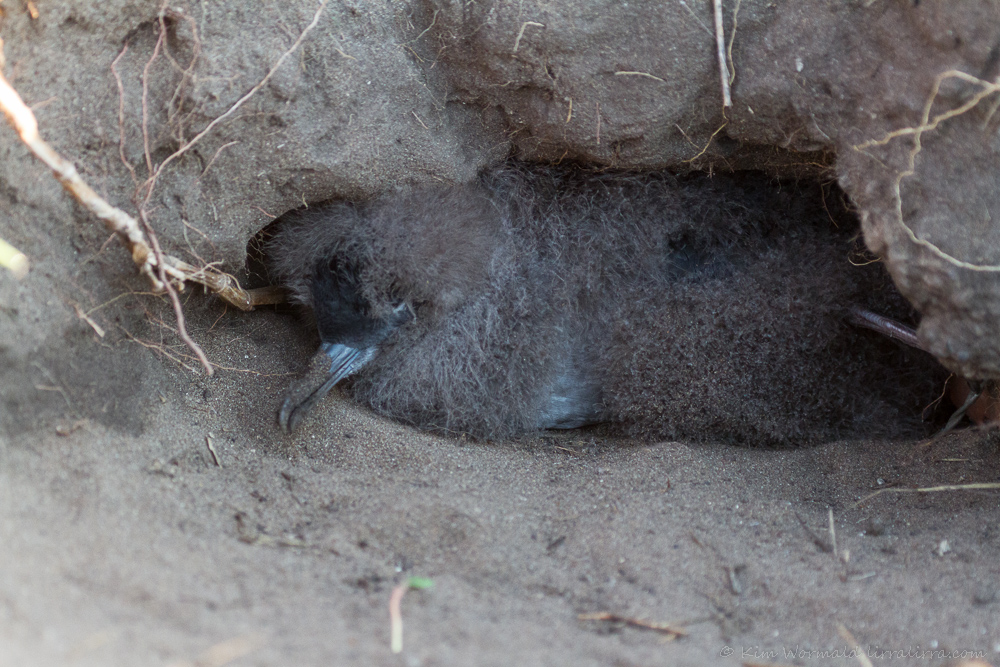The rather large bundle of fluff that I was lucky enough to see peeking out of its burrow had just been abandoned by its parents. They are winging their way to Alaska and their single nestling will follow in about two weeks, having fledged and without having eaten since they left. Short-tailed Shearwaters are one of the most remarkable species on the planet.
 Short-tailed Shearwater (Ardenna tenuirostris)
Short-tailed Shearwater (Ardenna tenuirostris)
Canon 7D, 100-400mm L IS USM, 1/400, f/5.6, ISO 1600, focal length 340mm
Despite the vast distances that Short-tailed Shearwaters cover their arrival times are remarkably predictable. Each year they arrive on our shores around the 23 September, their single egg is laid on 28 November, the adult birds leave on 12 April and the juveniles follow two to three weeks later. I often pass their colony but this was the first time I’ve seen a juvenile. I took the photos quickly as I didn’t want to disturb the bird or draw attention to it.
Short-tailed Shearwaters construct or repair burrows to raise their single chick, returning to the same location each year. The burrows are 1m-2m long with a leaf-lined nesting chamber at the end. The male Short-tailed Shearwater incubates the egg for the first two weeks while the female feeds at sea. During this time the male does not eat. Then they swap places with the male feeding at sea and the female not eating. They have two shifts during which they do not leave the burrow.
 Short-tailed Shearwater (Ardenna tenuirostris)
Short-tailed Shearwater (Ardenna tenuirostris)
Canon 7D, 100-400mm L IS USM, 1/400, f/5.6, ISO 1600, focal length 340mm
Short-tailed Shearwaters start breeding as older adults; females at 5 years and males at 7 years. This means that each breeding female has flown to Alaska and back 5 times. That’s 160,000km before she lays her first egg. Males have flown 224,000km before his mate lays her first egg. Those figures make me extra sad to think that the single nestling that arises from all this effort can be legally taken from its burrow and ‘harvested’ for its meat, oil and feathers.
Short-tailed Shearwaters are also known as muttonbirds, a nickname they were given by early European settlers who thought they tasted like mutton. Providence Petrels were also eaten by early settlers, they were wiped out by excessive ‘harvesting’ and by the impact of pigs trampling their Norfolk Island nests.
 Short-tailed Shearwater (Ardenna tenuirostris)
Short-tailed Shearwater (Ardenna tenuirostris)
Canon 7D, 100-400mm L IS USM, 1/400, f/5.6, ISO 1600, focal length 180mm
Short-tailed Shearwaters are privately and commercially harvested each year. It seems criminal to take a nestling from its burrow, kill it by dislocating its neck and stick it in a bag with 24 others – something that each permit holder can do each day of the season. But this pales in comparison with the 200,000 that can be taken commercially each year. Add this to the death rate associated with the rigours of migration, oil spills, inclement weather and gillnet fishing lines and perhaps there will be a time when Short-tailed Shearwaters are no longer our most abundant seabird.
Further information on these fascinating birds can be found on the web including at the Tasmania Parks and Wildlife Short-tailed Shearwaters page which ironically links to information about hunting and ‘humanely’ killing the chicks.
Happy birding, Kim

[…] Oh how I miss seeing these magnificent Short-tailed Shearwaters turn up each year. They migrate from as far distant as the Bering Sea and breed here. The youngsters, like the one above, are abandoned by their parents and left alone and unfed for two weeks as they to fledge. Then, and this is almost unbelievable, they take off and fly to the ice edge of the Antarctic. I’ve written more about them, and the dangers they face from humans, here: Short-tailed Bundle of Fluff […]
[…] We were on the island during May and the shearwater chicks that were still in the sand dunes were not expected to survive the winter. The adult birds leave the island by April, leaving the remaining chicks to fledge without food and make their own way to Papua New Guinea and the Philipines. Adults weigh up to half a kilogram and have a wingspan of almost one metre. It was sad to see the dead and dying birds on the beaches, and somehow even sadder to see this sweet chick and to wonder about its future. Short-tailed Shearwaters have a similar story but are under threat from humans who prefer to see them in recipes than in the wild, information and chick images can be seen by clicking Short-tailed bundle of fluff. […]
[…] the annual Australian harvesting of hundreds of thousands of Short-tailed Shearwater chicks (see Short-tailed bundle of fluff) please contact RSPCA Tasmania to ask about a campaign: rspca@rspcatas.org.au NB the Tasmanian […]
nices picture and silly story, i find it a shame to harvest that kind of chick
thanks kim
It’s hard to believe that killing the chicks is legal, I hope there’s nothing similar allowed in Europe. Actually I wonder if there are other legal chick hunts anywhere in the world …
Wow, I had no idea about them being harvested, that is disturbing.
It really is disturbing Mia. I’m hoping to hear back from the Tasmanian RSPCA soon, I’d like to know if there’s a campaign I could support and recommend.
Great post, The shearwater chicks are adorable.
Thank you Eileen.
That’s horrible! I can’t believe people could be so callous to kill a defenceless baby bird! And it’s so cute. Amazing photos as always.
I entirely agree, it’s hard to imagine anyone wanting to ‘harvest’ a chick. I’m glad you like the photos and I hope this is one little critter that’s safely on its way to Alaska.